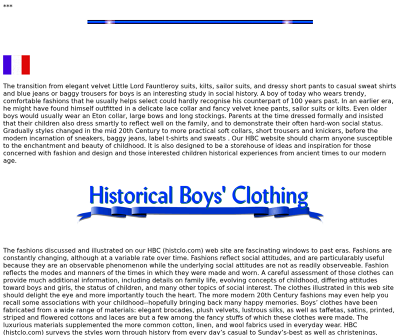
Addess:
, USEmail:
Not ReleasedPhone:
Not ReleasedAbout Us
The transition from elegant velvet Little Lord Fauntleroy suits, kilts, sailor suits, and dressy short pants to casual sweat shirts and blue jeans or baggy trousers for boys is an interesting study in social history. The mod boy of today who wears trendy, comfortable fashions he usually helps select would hardly recognize his counterpart of 100 years ago. In this earlier era, he might have found himself outfitted in a delicate lace collar and fancy velvet kneepants, sailor suits, or kilts. Even older boys in more mature suits would usually wear an Eton collar, large bows, kneepants, and long stockings. Parents at the time dressed formally and insisted that their children also dress smartly to reflect well on the family and to demonstrate their often hard-won social status. Gradually styles changed in the mid 20th Century to more realistic soft collars, short pants, and knickers before the modern incarnation of sneakers, casual baggy jeans, logo "T" shirts and sweatshirts.
Key Services in 2025
http://histclo.com/index2.html
- Historical fashion consulting
- Costume design for period films
- Children's fashion research
- Archival wardrobe curation
- Fashion history lectures
- Museum exhibit consulting
- Vintage clothing sourcing
